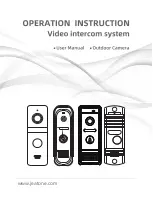
Caller ID Stack
Caller ID Stack
is the function to store IDs of callers in the stack memory.
The transceiver can store a maximum of 250 Caller IDs.
By selecting a Caller ID and pressing the
PTT
switch while in Stack Mode, the transceiver can respond to the Caller ID.
When the transceiver receives a call, the “
” icon blinks to notify that the ID is being saved. If the transceiver enters Stack
Mode, a user can check the stored IDs.
About the Caller ID Stack configuration
The transceiver behaves as follows according to the configuration in
Caller ID Stack
:
Table 3-10 Caller ID Stack
Configuration
Description
None
The Caller ID is not stored even if a call is received.
Individual Call
Only the Caller ID of an Individual Call or Paging Call is stored.
Any Call
The Caller IDs of all calls are stored. However, the Caller IDs of Unaddressed Calls and Broadcast Group
Calls are not stored in a DMR Conventional system.
Note
0
The transceiver stores in combination a maximum of 250 Caller IDs and Status Messages in the stack memory. If no
Status Message is stored, the transceiver stores up to 250 Caller IDs.
0
The storage method varies depending on the configuration in
Old Message Overwrite
.
Configuration using KPG-D1/ D1N
0
Configuring
Caller ID Stack
(P25) to be enabled of disabled (
Transceiver Settings > P25 > P25 Information >
General > Stack)
0
Configuring
Caller ID Stack
(NXDN) (
Transceiver Settings > NXDN > NXDN Information > General > Stack)
0
Configuring
Caller ID Stack
(FleetSync) (
Transceiver Settings > FleetSync > FleetSync Information > General
> Stack)
0
Configuring
Caller ID Stack
(MDC-1200) (
Transceiver Settings > MDC-1200 > MDC-1200 Information > General
> Stack)
0
Configuring
Caller ID Stack
(DMR) (
Transceiver Settings > DMR > DMR Information > General > Stack)
3 BASIC OPERATIONS
3.7 Viewing the Receive History (Stack)
Common FUNC (K, F)/Ver 2.20
56
















































